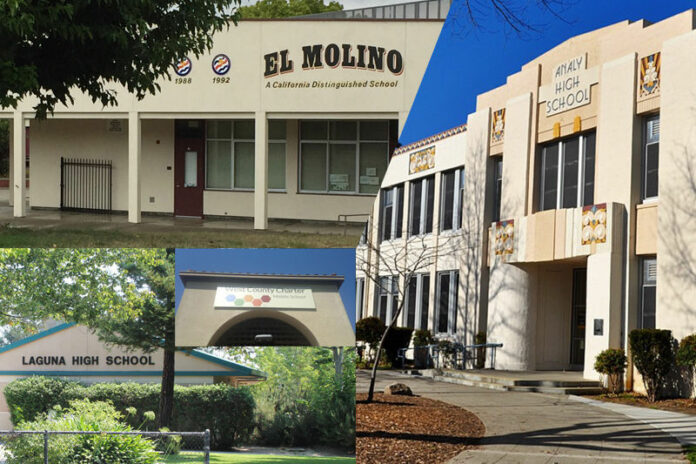Help is on the way for seniors of the West Sonoma County Union High School District (WSCUHSD) whose diplomas are on the line after nearly a full year capsized by the COVID-19 pandemic.
At the Feb. 10 board meeting, the WSCUHSD Board of Trustees approved a variance in credits needed for graduation for specific seniors from Analy and El Molino High Schools pulling through exceptional circumstances.
Back in October, district administrators across Sonoma County assembled to discuss the widespread upsurge of Ds and Fs and other difficulties that had befallen the youth in the distance learning model, with a run of traumas that could impede the path to graduation, Superintendent Toni Beal said.
WSCUHSD administrators found a way to get 22 Analy and El Molino seniors identified so far across that threshold by seeking to extend an existing board policy that allows a variance in graduation credits for continuation high schoolers at Laguna High in special cases, according to Beal.
She said Board Policy and Administrative Regulation 6184 is available to Laguna students every year, while the now-approved variance for Analy and El Molino students applies to just the 2020-21 school year.
The 17 Laguna seniors identified this year have already been approved for the variance for exceptional circumstances, Beal said in a Feb. 11 interview.
Beal said administration and counselors actively working together have already identified the students that qualify for the alternative track — 12 Analy students and 10 El Molino students up to this point.
“Students cannot self-select,” the superintendent said in a Feb. 11 interview. “(These are) students that have been identified as being in a challenging situation that would put them in a position to not be able to earn the full credits.”
In other words, seniors cannot make an eleventh-hour appeal to graduate with less than the 230 credits required by the district.
During her presentation to the board, Beal went over the “Variance on Graduation Requirements” form that school staff would use to document that the selected students met the state requirement for 130 credits and 60 more for a total of 190 credits to graduate.
“They would then document the exceptional circumstance that each of the students had exhibited and the counselor and principal would sign it,” she said. “They would meet with me. We would have a conversation about why the student would be granted the 190-credit graduation and then I would sign that form.”
She said Santa Rosa City Schools District and others pursued a three-track approach for securing the credits, but WSCUHSD found each of its own seniors could make it out with 190 credits.
“The diploma would not be different for these students in any way,” Beal said, except the form would go into the students’ cumulative file “so you would know how they earned the 190 credits.”
Students receiving this support would still need to fulfill state-mandated courses like English and U.S. history, but they could get their diplomas with 30 English credits instead of the 40 credits the district normally requires, she said.
This means an identified student could afford to fail one English class, but must pass English all other three years of English, according to Beal on Feb. 11.
El Molino is the only school in the district that requires that 12th graders fulfill a senior project as part of their English class, an assignment identified students still need to complete, so administrators and teachers will work with them on adjusted requirements, Beal said.
While the diplomas are the same, those who don’t plan to head to a community college may need to investigate with their counselor on whether they qualify for California State University (CSU) or University of California (UC) admissions because those universities can have different prerequisites, according to Beal.
Lily Smedshammer, president of the West Sonoma County Teachers’ Association, said the district’s seven-period day is probably what made it possible for WSCUHSD to build up enough credits to graduate with 190 credits compared to Santa Rosa students.
Trustees pass CVRA resolution to change election method, approve yearly school plans for student achievement, monthly reports and next school year’s calendar
The WSCUHSD Board of Trustees also received a presentation on the California Voting Rights Act of 2001 (CVRA) by attorney Jonathan Salt of Fagen Friedman & Fulfrost LLP and passed a resolution to transition to a by-trustee area election system (check back for a full article in the coming days).
In addition, the board approved Analy, El Molino and Laguna’s single plans for student achievement (SPSAs) that are required annually so the district can receive Title I, Title II and Title III federal funds.
Analy Vice Principal Sandy Frey discussed goals of more student engagement and better school climate and conditions of learning, as well as more career technical education (CTE) pathways, college and career readiness resources like Naviance software.
Frey also spoke to increasing access to Advanced Placement and honors classes, reclassifying more students as English-proficient, building common assessments in each department and more.
El Molino Vice Principal Dani Barese addressed goals such as more data-informed decision-making, taking an interdisciplinary approach with more project-based learning and developing common benchmark assessments. She said the school was taking lessons from its previous student D and F reports and seeking to increase CTE pathways.
Barese also said El Molino pursues the goal of meeting or surpassing the state average A-G completion rate, or the percent of high schoolers who pass enough specific classes needed to enroll at a UC or CSU, according to EdSource, an organization for education research.
Like Barese and Frey, Laguna Principal Allie Greene spoke to developing more opportunities and success for students after high school. She said around 89% of students wanted to go to Santa Rosa Junior College (SRJC), but only 6% of Laguna students last year attended a post-secondary institution. She said she hopes to get more articulated SRJC classes through Laguna, as well as more hardware and software for students to learn web-based design and coding.
With a 55% graduation rate in 2020, Greene said Laguna seeks to graduate more students who arrived at Laguna because they had narrowing chances of reaching the finish line. Plans to incorporate a restorative justice program are also in the works, as well as developing more self-regulation skills, counseling resources and community connections, she said.
Towards the end of the meeting, the board approved a brief monthly budget update from Chief Business Official Jeff Ogston, a swift monthly personnel report from Director of Human Resources Mia Del Prete and the 2021-22 school year calendar.









